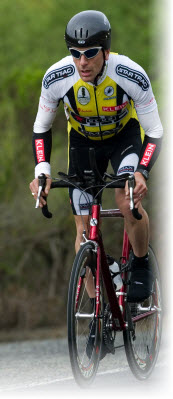 By Team ICG® Master Trainer Jim Karanas -
By Team ICG® Master Trainer Jim Karanas -
What’s the use of a state-of-the-art bicycle and a robust training plan if the rider hasn’t developed spirit or mental control?
Many coaches will tell you that no equipment or training method has value unless it helps to develop your spirit. Those coaches search for ways to infuse a calm and balanced mental attitude in their students and assure heightened clarity of perception. They may turn to enlightenment/spirituality to help students understand life better and cope with its complexity.
In the pursuit of effortless power on the bike, you must know that you are more than your intellect tells you. Training that emphasizes discipline of mind and recognition of spirit is paramount in that. To my understanding, two concepts are the basis of all training: center and intrinsic energy. In previous posts, I’ve referred to these as balance and aliveness or vitality.
I first witnessed effortless power in the mid-1970s at a martial arts demonstration. An aikido master displayed the power of ki (or chi), our intrinsic energy. With the slightest shove, he sent the five students attacking him into the air and onto the floor. The attackers appeared to be on wires doing a Hollywood stunt.
The next time I witnessed it was in the late 1990s at an indoor rowing regatta. The women’s world record holder for 2000 meters was on a rowing ergometer, warming up for the upcoming heat. The power output on her computer and the ease with which she rowed simply did not match. It was the first time I witnessed the combination of advanced fitness and the effortless generation of power.
I saw it again in 2002, during an annual time-trial up Mt. Diablo in Northern California. I was pursuing the coveted “under an hour” t-shirt for the 10.8-mile, 3200’ ascent. Most of the way, I followed a giant of a man, 6’4” tall, who outweighed me by 50 lbs. He wasn’t built for climbing but floated up the mountain effortlessly. He broke the hour and I did not. What I saw didn’t match what I believed he should have looked like on that climb.
My first personal experience with effortless power was in 2006, during the Furnace Creek 508, which I rode in 33 hours and 49 minutes, qualifying for RAAM. It was my pinnacle in cycling, training and racing. During my race preparation, my coach instructed me to “forget everything you think you know about cycling.” I learned that you can’t train your way to effortless power.
Although effortless power is not a result of fitness, fitness does result from the necessary training that culminates in effortless power. The simplicity is what I still struggle with, even to this day. It’s not a constant state, being centered and channeling intrinsic energy. The last time I experienced it was in 2008.
Center, maintaining balance, is always a struggle because of our chaotic reality. I spoke with one of my mentors recently about the difficulty of maintaining balance if you’re involved with business, friends and family, or are at an age where health matters manifest. Balance is more achievable when things are simple. In our society, living simply takes great discipline and sacrifice. Our balance is in constant flux, and so is our ability to achieve effortless power.
Sensing intrinsic energy is easier for some than for others. It’s not a simple declaration that you’re happy to be alive. It’s not a thought at all. Thinking obscures the sensation of feeling alive, even though it’s inherent in everyone. It takes discipline and practice to stay constantly aware of it, even more so to direct it. I spend time in all my classes searching for new ways to communicate the sensation. Without it, effortless power can’t be experienced.
In part 1, “What About The Watt?” I alluded to an indoor cycling practice that uses watts for something more meaningful than measuring power and improved fitness (along with its inevitable decline).
The watt measures force. How much force you can apply is a perception. So watts represent a limitation — in your mind — of your ability. Typically, to improve your ability to generate watts, you train your fitness. This improvement is short-lived. My experience is that generating watts beyond your current belief system is largely unrelated to fitness. It’s related to balance and your ability to coordinate and direct your intrinsic energy.
If the training you provide in your classes deals solely with fitness improvement, your students will never sense effortless power. Their watts may go up for the short term, but will eventually decline and disappoint. If, instead, the training you provide deals with achieving balance and coordinating the sensation of life, the students’ watt display will, at times, feel effortless, regardless of age. The pursuit of that engages the student for life and will lead to greater clarity and understanding.
Accepting that effortless power happens can be difficult, but becomes more possible once you witness it or experience it yourself. To experience it, however, you must have the discipline to deviate from the way you currently train and train others.
You can experience this through indoor cycling and using watts. My next post will provide pragmatic, specific, how-to exercises for leading yourself and your students to effortless power.
Originally posted 2012-12-10 04:43:02.
- Spinning Our Wheels:Can’t We Go Faster? - February 24, 2024
- Still More on Motivation - January 1, 2024
- Differentiation:ICG® Academy Opens in San Francisco - December 23, 2023

Jim…..thank you very much (once again)
I’ve been attemtpting to incorporate the concept of *effortless power* ( in an environs where the *effortless* transcends the *power* )…
Vivienne